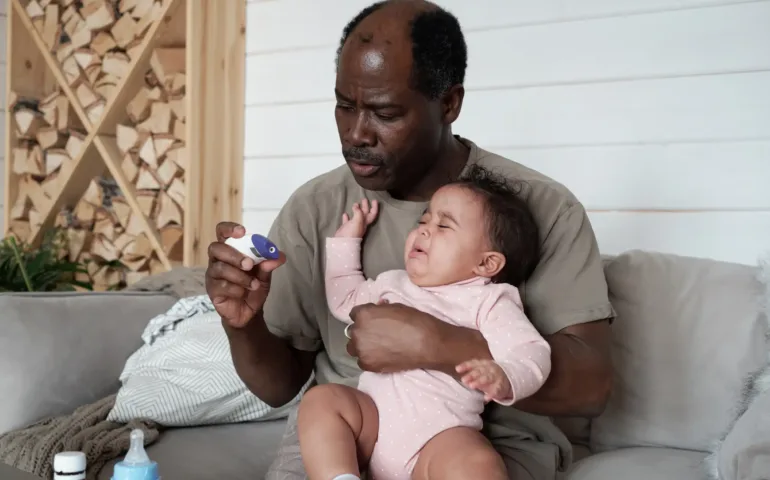
Many women experience pain during their periods: cramps, sore breasts, backaches, headaches… It’s also possible to feel pain during ovulation. It even has a name: Mittelschmerz (mittel = middle / schmérz: pain). Is this normal? What does it mean?
Let’s take a look at the origin of this pain and possible treatments.
Why do some women feel pain at the moment of ovulation?
The female cycle is divided into four phases:
- The follicular phase.
- The fertile ovulatory phase.
- The luteal phase.
- Menstruation.
You can also track your cycle in the May app.
The second phase of the menstrual cycle, as its name indicates, corresponds to ovulation (this is when you have the greatest chance of getting pregnant). During this phase, it’s possible to feel your body working, which can be uncomfortable or even painful. But why?
- Before ovulation, the ovarian follicle increases in size.
- After ovulation, the follicular fluid flows behind the uterus.
- Before and after ovulation, you may feel certain movements of the fallopian tubes.
However, we recommend that you pay close attention to what you feel; it’s also possible that this pain has nothing to do with the ovulation period. If it’s too intense or seems abnormal to you, don’t hesitate to consult a healthcare professional.
How can I recognize characteristics of ovulation-related pain?
Ovulation-related pain can be similar to what you feel during your period:
- cramps,
- bloating,
- breast tenderness,
- tightness in the lower abdomen (sometimes on the left, sometimes on the right, or in the middle).
These sensations are normally much less intense and shorter than those felt during menstruation.
How long does ovulation pain last?
The duration of ovulation-related pain varies between women and cycles. It can last a few hours, a day, or at most two days. And remember, it shouldn’t be too intense. Otherwise, we encourage you to consult a healthcare professional.
What remedies can relieve ovulation pain?
Unfortunately, there’s not much you can do if you experience pain during ovulation.
You can try to relieve it in the same way you would period pain.
- Take a nice hot shower or bath (if that’s not possible, a hot water bottle is also very effective!).
- Massage your abdomen or lower back.
- Rest as much as possible.
- Go to a pharmacy and ask the pharmacist for advice; they may be able to provide you with an appropriate pain reliever.
To stop ovulation, you also have the option of taking oral contraception, getting a hormonal IUD fitted, or an implant. These contraceptive methods work by stopping ovulation to prevent pregnancy. Don’t hesitate to discuss this with your GP, a midwife (we have a whole team available via the May chat 7 days a week from 8 a.m. to 10 p.m.), or a gynecologist if you have questions.
When should I see a doctor if I have pain at the time of ovulation?
Once again, pain that is too intense during ovulation should be a warning sign. We strongly encourage you to see a healthcare professional when it becomes bothersome, or to call 15 if it’s a stabbing, persistent pain.
The topic is concerning, but it’s important to know: other factors can cause lower abdominal pain, such as the rupture of an ovarian cyst (an abnormal fluid-filled mass, often benign), an adnexal torsion, or even an ectopic pregnancy (when a pregnancy develops outside the uterus). That’s why at the slightest doubt, we recommend consulting.
Want to learn more? Feel free to download the May app, where you’ll find plenty of resources to support and guide you throughout your pregnancy.
Can ovulation pain affect my fertility?
Feeling pain during ovulation does not necessarily indicate a problem with fertility or ovulation.
However, if in doubt, certain tools and tests can help you assess the quality of your ovulation:
- Basal body temperature tracking: to observe your ovulation and assess its regularity, you can analyze your temperature chart. Every day, at the same time and before getting up, take your temperature with an oral, vaginal, or rectal thermometer. It will rise by about 0.3 to 0.5 °C once ovulation has occurred (and until the end of the cycle), indicating the timing of your ovulatory phase and the length of your menstrual cycle.
- Ultrasound and blood tests: your doctor may prescribe a laboratory blood test to establish a hormonal profile and make sure everything is fine, along with an ultrasound.
Good to know: endometriosis can also cause pain during ovulation, during periods, and even during intercourse. If in doubt, we encourage you to make an appointment with your GP, midwife, or gynecologist to establish a diagnosis.
As you’ve understood, it is normal to feel some pain during ovulation. However, if this discomfort reaches period-level pain, or worse, that’s not normal; we encourage you to call your doctor or 15.
–
Photo: prathanchorruangsak
This text was translated from French by an artificial intelligence. The information, advice, and sources it contains comply with French standards and may therefore not apply to your situation. Make sure to complement this reading by visiting the May US/UK app and consulting the healthcare professionals who are supporting you.




